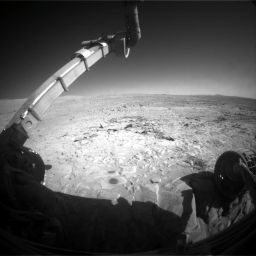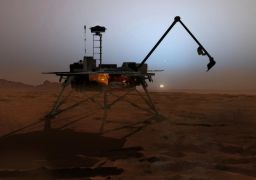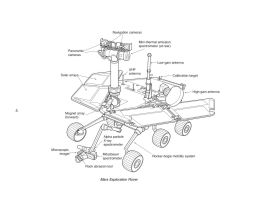A.J.S. Rayl • Mar 31, 2008
The Mars Exploration Rovers Update: Spirit Takes in Home Surroundings, Opportunity Roves to Cape Verde
Brandishing the trademark resilience that has endeared them to millions of people around the world, the Mars Exploration Rovers kept their robotic noses to the grindstone through March, soldiering on into their third Martian winter with slightly more power than predictions anticipated and enough proven mettle to dodge a budgetary pothole on Earth that might have taken one of them out of action. Now, 50 months after Spirit defied the odds and bounced safely to an upright landing and Opportunity followed with the impossible scoring of a 300-million-mile hole-in-one, the twin robot field geologists are driving the MER mission into new territory once again.
At Gusev Crater, Spirit, which hunkered down in a chosen spot just off the northern edge of Home Plate last month, stayed put through March. The rover's final February drive, on Sol 1464 (February 14, 2008), would be its last drive, the MER team decided, until spring blooms on the southern hemisphere of Mars, around about September, said Jake Matiijevic, chief rover engineer at the Jet Propulsion Laboratory (JPL), the NASA center from which the rovers are wrangled.
Darkened with dust fallout from the global storm last June-July, Spirit has officially been on a reduced, winter operations schedule. That means, essentially, the rover works 1 to 1.5 hours, then spends the following sol primarily recharging its batteries. But true to the MER nature -- as well perhaps as Mars' growing "affection" for the rovers in "raining" less dust down in March than models predicted -- Spirit took in enough sunlight "fuel" to conduct its winter science campaign without disruption. "We're doing surprising well," said Steve Squyres, the principal investigator for rover science, during an interview Friday from his Cornell University office.
Using its instrument deployment device (IDD) or robotic arm, Spirit has been reaching out all month from its stationary position with its various instruments and cameras, checking out the strata of bedrock that form the circular volcanic plateau called Home Plate. Settled in for winter, the rover has plenty of time to zero in on specific targets within arm's reach for detailed study, each being named in honor of the famed Tuskegee Airmen. Beyond that work and its routine atmospheric observations, the rover has maintained enough energy this past month to start looking around the landscape with its stereo panoramic camera (Pancam) "eyes" and begin snapping images that will be "stitched" together in one of the huge 360-degree panoramas, this one named for the legendary space artist Chelsey Bonestell. As April and the Martian winter move in, Spirit will carry on with its current this winter science campaign as power levels permit.
On the other side of the planet, Opportunity, likewise, conducted a steady, amount of science at Meridiani Planum, from a solitary position as it maneuvered its arm in and out of position to finish its close-up examinations of targets in the Gilbert layer. The layer of bedrock lies just below the band of three layers -- dubbed Steno, Smith, and Lyell -- which circles the interior of Victoria Crater. "We have finished up the science at Gilbert," Squyres announced. "We got a good RAT hole in Gilbert_A and got good APXS chemistry data, and we saw some very definite trends in the chemistry relative to what we've seen further up the slope."
What Opportunity found in those layers correlates with what it found at Endurance Crater some six kilometers back, broadening the findings. "Recall that in Endurance Crater we had a jump in chlorine as we went deeper and a change in the magnesium sulfate levels as we went deeper," reminded MER science team member Albert Yen, of JPL. "With this Gilbert measurement, we confirmed that the magnesium sulfate levels dropped at this lower portion within Victoria." Noting that a lot of people have been thinking about this correlation, Yen said the main idea that's surfaced is that there the water and forces involved in the production of this chemistry appear to have been present on a regional scale. "But we're spending more time thinking about this."
Opportunity, meanwhile, has powered up and taken off for the base of Cape Verde, driving 5.5 meters (18 feet) on Sol 1484 (last Thursday, March 27, 2008) and another 5 meters (16.4 feet) or so on Sol 1486 Saturday (March 30, 2008). A third drive planned for tomorrow. "This is going to be one of the most interesting and challenging and exciting things we've ever done with these rovers," said Squyres. "We're going to get as close as we can."
Surviving the harshness of Mars is something the rovers have made history doing, but some of Spirit and Opportunity's most life-threatening moments have come, however ironically, from forces on Earth. Earlier this month, a directive from the head of the Planetary Science Division at NASA headquarters, James Green, arrived on the desk of Fuk Li, head of the Mars Exploration Program office at JPL in the form of a letter ordering $16 million in reductions in the program, including $4 million in rover operations this year. If implemented, the ordered cuts would no doubt require one of the rovers be put in a state of hibernation and an unspecified number of team members to be let go.
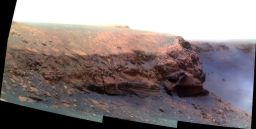 Cape Verde
Cape VerdeOpportunity took this false-color image of Cape Verde, one of the promontories that juts out from the rim of Victoria Crater with its Pancam on Sol 1329 (Oct. 20, 2007), more than a month after it began descending down the crater walls, and just 9 sols shy of its second Martian birthday on Sol 1338 (Oct. 29, 2007). Opportunity landed on the Red Planet on Jan. 24, 2004.
Credit: NASA /JPL-Caltech / Cornell
The media response was swift and the news broke Monday, March 24, as the Associated Press, CNN, and major newspapers ran stories. Hours later, however, the directives pertaining to the rovers in the letter were rescinded. The orders apparently had not been "fully coordinated" with NASA Administrator Michael D. Griffin.
"The NASA Administrator stated that no Mars rover operations will be suspended or shut down," read the official statement issued by NASA headquarters. "This means that the Mars Exploration Program will not take any action as a result of the initial letter."
For a minute the story evolved from an MER story to a story that harkened back to Hubble's cancellation and the plan to pull the plug on the twin Voyagers and what inevitably happens when NASA threatens to end highly successful missions popular with the public. The story further evolved when it was announced that Alan Stern, the associate administrator at NASA headquarters who oversaw the science budget, had resigned and Ed Weiler, who previously held the post, was brought back to headquarters from the Goddard Space Flight Center.
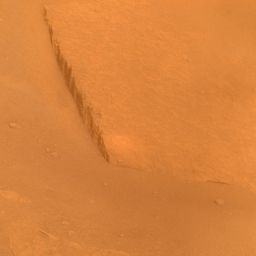 Gilbert in living color
Gilbert in living colorOppotunity took this image of the Gilbert layer it investigated inside Victoria Crater this month with its Pancam during the final week of the month. You can barely see the circular area it brushed with its RAT, right at the tip of the layer.
Credit: NASA /JPL-Caltech / Cornell
Although the rovers survived to rove on, the underlying problem facing all science and planetary exploration missions at NASA hasn’t gone anywhere. The Mars Science Laboratory (MSL), which is scheduled to launch next year, has been running into problems because of its "complexity," and needs more money "for a larger workforce and a redesign of the entry heat shield after failure of the original," according to the same official NASA release that assured the continued operations of Spirit and Opportunity. The official stated also noted that "[b]udget reviews are ongoing in an effort to identify additional funds" for MSL.
Since the new Moon program and the development of NASA's new spacecraft, Ares and Orion, are each encountering development problems and are already commanding the bulk of the agency's dollars, and considering that science is already cut pretty close to the bone, it is not clear exactly where those "additional funds" are going to come from.
"The science program is facing extraordinarily difficult budget constraints within NASA," said Louis Friedman, executive director of The Planetary Society.
Those constraints were very much on the mind of those at a hearing held March 13 by the House Science and Technology Committee’s Space and Aeronautics Subcommittee to examine the state of the agency's space and Earth science programs as reflected in the Administration’s fiscal year 2009 (FY09) budget.
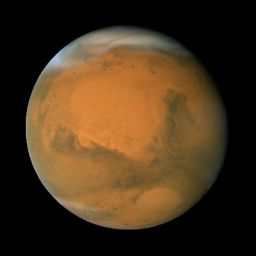 Mars during the 2007 opposition
Mars during the 2007 oppositionThe Hubble Space Telescope took this photo of Mars during its 2007 opposition, when it was about 90 million kilometers from Earth. This view was captured on Dec. 3, 2007 and is centered at a longitude of about 320 degrees.Credit: NASA, ESA, the Hubble Heritage Team (STScI/AURA), J. Bell (Cornell University), and M. Wolff (Space Science Institute, Boulder)
"I’m concerned that NASA’s science program is facing an uncertain future under the funding plan offered by the Administration," stated Subcommittee Chairman Mark Udall (D-CO). "NASA’s challenging new science initiatives are to be built on a budget that increases by only 1% through FY11, and that assumes only inflationary increases at best in the years beyond that. There will be little new money -- instead, there will be a continuing need to transfer of funds across the science accounts to support each new initiative -- an approach some might call ‘robbing Peter to pay Paul’. I’m very concerned that such an approach will not prove sustainable or credible."
Squyres, who testified before the Subcommittee, found the "greatest concern" within the Solar System Exploration budget to be with the Mars Exploration Program. "NASA has described an exciting future program of Mars exploration," he said, noting the ongoing operations of Odyssey, Spirit and Opportunity, the Mars Reconnaissance Orbiter, Phoenix, which is to land in May, and the Mars Science Laboratory rover, to launch in 2009.
Those current Mars missions are to be followed, Squyres noted, by an orbiter mission in 2013, another major science mission in 2016, then, in 2018 and 2020, the orbital and surface elements of the long-awaited Mars Sample Return that will at last "directly" address, "what has been one of the highest priorities in Mars exploration for many years," as he testified. But the FY09 budget request "does not appear to contain adequate funds to carry out this program," he added, basing his assessment on a Mars program architecture study in which he participated with 19 senior engineers recently and which was chartered by NASA to respond to a request from the Office of Management and Budget. For more information, visit the Committee’s website at www.house.gov/science.
 Steve Squyres
Steve SquyresA former student of Carl Sagan's, Steve Squyres is the Goldwin Smith Professor of Astronomy at Cornell University. He spent 10 years proposing missions to NASA before the MER mission was chosen for flight. He has served as the lead scientist for both Spirit and Opportunity, which have now been roving for more than four Earth years.Credit: Cornell University
Simply put, the cuts called for in the Administration’s 2009 NASA budget would deeply impact Mars exploration at a time when the field is bursting with findings from both the ancient past as well as the present. During just the last several weeks, a team working with data from the Mars Odyssey orbiter reported evidence of salt deposits that point to places where water once was abundant and evidence might exist of possible past Martian life, the High Resolution Imaging Science Experiment (HiRISE) camera team from the Mars Reconnaissance Orbiter (MRO) mission released stunning pictures of avalanches in action, and Opportunity made the discovery of evidence for a more expanded realm of past water in Meridiani.
"Mars exploration drives public interest in space The Planetary Society wrote in its invited letter to the subcommittee. "As Mars is the only planet we know, besides Earth, with accessible oxygen and water, it is a focus for understanding life and habitability of other worlds . . . it is not time to turn off exploration -- it is time to move to the next exciting stage."
On March 20-21, Squyres along with other MER representatives and representatives from every current Mars exploration mission gathered at JPL to present their recent science results, future plans, and budget requirements – and basically defend their missions. A Review Board charged with giving feedback to NASA headquarters was there to take it all in. "I felt our presentation to the Review Panel went very well," Squyres said.
Spirit and Opportunity are positioned as well as any spacecraft or robots could be to survive the slings and arrows of the space business and for now they continue to rove on into new ground. But there may be no guarantees anymore, even for robot heroes. At the time this story had to post, the Review Board's recommendations had not been announced.
Spirit From Gusev Crater
As February turned to March, Spirit was checking out the bedrock target, named after Wendell O. Pruitt, a Tuskegee Airman who hailed from St. Louis, Missouri. The ground targets in the rover's immediate vicinity are all being named in honor of distinguished members of the Tuskegee Airmen, the popular name for the 332nd Fighter Group, an all African-American unit of the U.S. Army Air Corps that served in the European Theater during World War II.
 The Art of Chesley Bonestell
The Art of Chesley BonestellThis image shows the dust jacket cover of The Art of Chesley Bonestell by Ron Miller and Frederick C. Durantt III, published by Collins & Brown Ltd, 2001. Arthur C. Clarke, who wrote the forward for the book, defined Bonestell's impact as "colossal."Credit: Collins & Brown Ltd.
After taking some full-color panoramic camera (Pancam) pictures of rock targets named for Bennett Hardy and super resolution images of Reuben C. Franklin at the end of February, Spirit began acquiring on Sol 1477 (Feb. 28, 2008) the first of the hundreds of images needed to create the 360-degree panorama of its winter haven surroundings, being named for Chelsey Bonestell (1888-1986), regarded by many as the most influential space artist of all time.
It may not be possible to adequately convey just how much of an influence Bonestell's art had on scientists and curious, rocket minds everywhere, not to mention on science and science fiction. "As they did for all my generation, Chesley's paintings had a colossal impact about my thinking about space travel," Arthur C. Clarke once said. His assessment appears on the jacket of The Art of Chesley Bonestell by Ron Miller and Frederick C. Durant III (Collins & Brown Ltd., 2001), a book for which Clarke wrote the forward.
Planetary Society co-founder Carl Sagan agreed with Clarke, saying that he didn't know what other worlds looked like until he saw Bonestell's paintings of the solar system, something Miller and Durant noted in their introduction.
"Since this was going to be a big, beautiful picture, we thought who better to name it after than Chesley Bonestell?" said Squyres. And so it was.
On Sol 1479 (March 1, 2008), Spirit positioned the wire brush on its rock abrasion tool (RAT) on the surface of Wendell Pruitt, but the instrument failed to sufficiently brush the target. While engineers at JPL began the troubleshooting to figure out why, the rover turned its attentions to conducting the routine monitoring of atmospheric dust levels with the panoramic camera (Pancam), checking for drift or changes with time in the miniature thermal emission spectrometer (Mini-TES), then using that instrument to survey the sky and ground.
In the sols that followed, Spirit continued its "cycle" of IDD work, Squyres said. Sometimes it looked at the atmosphere for argon. Sometimes it looked at the surface and the rocks in front of it, and other times, it checked out targets on itself, such as the magnets.
 Tuskegee Pan
Tuskegee PanSpirit finished taking the hundreds of images required to make the Tuskegee Panorama in January 2008 and Jim Bell, the panoramic camera lead, mosaiced those images into the finished product. The rover took the images from Sols 1412 to 1428 (Dec. 23, 2007 to Jan. 8, 2008) as it moved into place off the edge of Home Plate North, its third winter haven. This vantage point provides a particularly good view of the rugged top of Home Plate.Credit: NASA / JPL - Caltech / Cornell
As part of the winter operations schedule set some weeks ago, Spirit downlinks its collected science data only every three sols or so, though it is taking commands from Earth via its X-band more regularly. "Most of the science plans now take a sol and then there is a recharge activity in between," said Matijevic. So the rover is continuing with the general pattern of one sol on, one sol off to recharge and really doesn't need to downlink as often. During the first part of March, for example, Spirit recharged its battery on Sols 1485, 1487, 1488, and 1490 (March 7, 9, 10, and 12, 2008). On those recharge days, the rover conducted minimal science or no science and did not relay Earthbound data to the Odyssey orbiter as it passed overhead.
On Sol 1484 (March 6, 2008), Spirit once again turned its RAT to Wendell Pruitt and this time successfully brushed the surface of the bedrock target. It then acquired a single-frame, high-resolution image of the area right in front of it with its navigation camera and took some stereo images with its front hazard avoidance cameras. The rover wrapped the first week of March by taking some super-resolution Pancam images of a rock target named for Tuskegee Airman Lucius Theus and recharging its battery on Sol 1485 (March 7, 2008).
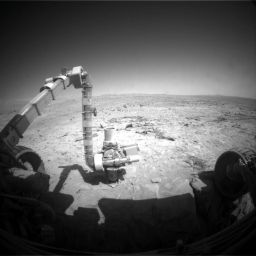 Checking out Wendell O. Pruitt
Checking out Wendell O. PruittSpirit took this image with its front hazcam on Sol 1476 (Feb. 27, 2008 as it was preparing to check out Wendell O. Pruitt, the target named for the famed Tuskegee Airman who flew one of the red tail P-51 Mustangs into World War II history in the 1940s. It shows the rover's final wintering position on the edge of Home Plate North. It will stay here for the next five or six months.
Credit: NASA / JPL-Caltech
As the second week of the month got underway, Spirit continued its inspection of Wendell Pruitt and collection of pictures for the Bonestell Pan. On Sol 1486 (March 8, 2008), the rover acquired a stack of stereo microscopic imager (MI) pictures of Wendell Pruitt, then with the Pancam surveyed the horizon, took spot images of the sky for calibration purposes, and monitored dust on the rover mast. It took another single frame, high-resolution image of the area in front of it with its navigation camera, as well as more stereo images with the front hazard avoidance cameras.
On the morning Sol 1487 (March 9, 2008), the rover took more full-color pictures for the Bonestell Panorama, then spent the rest of the Martian day recharging the battery. The following sol, the rover took more "sky flats" -- images of the sky for calibration purposes -- and acquired more super-resolution Pancam images of the target named after Tuskegee Airman Theopolis Johnson. After relaying data to Odyssey on Sol 1489 (March 11, 2008), Spirit placed the alpha-particle X-ray spectrometer (APXS) on Wendell Pruitt, but postponed data collection with the instrument to conserve power for an operational readiness test in support of the Phoenix mission scheduled for Sol 1491 (March 13, 2008).
The following sol, Spirit continued its collection of the Bonestell Panorama and recharged its batteries. Late the next Martian morning, on Sol 1491 (March 13, 2008), the rover transmitted a tone at UHF frequencies directly to the Green Bank radio telescope in West Virginia for its part in the operational readiness test for support of Phoenix, which is en route to Mars and scheduled to land near the planet's north pole on May 25.
By mid-March, Spirit wrapped up its work at Wendell Pruitt and its campaign of super-resolution Pancam images of Lucius Theus and Theopolis Johnson as the JPL engineers turned their attentions to dealing with a little issue involving the mast holding the Pancam and navigation camera. "Because of the geometry -- the location of the Earth in the sky -- and the time at which we're doing our data uplink, the high-gain antenna is partially obscured by the head of the PMA [panoramic camera mast assembly]," said Matijevic.
In essence, the engineers addressed that problem by implementing a capability in the flight software that anticipates and addresses this particular problem. "The flight software actually makes a decision about the branch of the high-gain antenna to use for the purposes of accomplishing, in this case, an X-band uplink," explained Matijevic. "In the last two weeks, we have invoked this particular software algorhythm as a commanded event at the time of the uplink pass and we've avoided the entire problem by exercising that software capability," he said. "We're about ready to make that a permanently enable capability and let the software take care of that from this point on."
During the news coverage last week that involved the rovers, word circulated in some reports that Spirit was more or less in hibernation. Part of the confusion may have come from the Spirit mission report on the JPL site that noted: "During the next few months, the rover will increasingly go into a "hibernate" mode as the [S]un continues to dim."
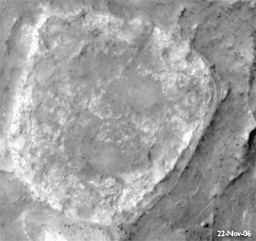 Spirit explores Home Plate
Spirit explores Home PlateMore than a year of Spirit's examination of Home Plate, the circular, volcanic feature in the Columbia Hills region of Gusev Crater, is chronicled in this animation of nine images from the HiRISE camera on the Mars Reconnaissance Orbiter, covering an area of about 100 square meters. The geometry of Home Plate appears to shift from image to image, because the orbiter often had to turn to one side or the other of its orbital track across Mars in order to see Spirit. That means it usually saw the raised topography of Home Plate from a point that was not directly over Spirit's head. Some shifts in the features are actual distributions of dust around Home Plate caused by the Martian winds. The dust storm of summer 2007 almost completely blocks the view of Spirit at one point during the animation.
Credit: NASA / JPL / UAz / D.Ellison
In any case, Spirit is not in hibernation, nor are there any plans for it to go into a real hibernation. "The vehicle is actively [working] every day," said Squyres. "MER-A did five plans this week."
"It's actually something of a misnomer," Matijevic clarified. The best analogy for a hibernate mode, he said, was the state they put Opportunity in back in June 2007 during the global dust storm. "At that time, the vehicle was strictly doing activities that were engineering, survival activities meant to keep the vehicle up for communications sessions." If there were a science measurement taken, it was strictly an atmospheric measurement like the taus -- taking pictures of the sky with the Pancam to gauge the dust opacity of the atmosphere -- that Opportunity really had to do to get a good power estimate. "Otherwise, we kept it asleep as much as possible," he said. "This isn't the mode I anticipate we will be in throughout this winter [at Home Plate North] with Spirit."
Dust continues to fall from the sky and onto the rover's solar arrays. "But it is at a lower rate that what we were anticipating for this late fall, early winter period and that's good news," said Matijevic. "The other thing is the tau has been lower than what we had anticipated for after the dust storm last July. They've actually kind of worked together to sort of stabilize the energy production on the vehicle and we have kind of predictable energy available for science activities during the last few weeks." Spirit's power levels have been holding at around 250 watt-hours. "That's very good," he said. "And it is fine for doing the activities the vehicle has been doing."
The primary focus for Spirit during the last week or so has been to image the magnets on itself, said Squyres, and continue taking pictures for the Bonestell Pan. "Here's a beautiful picture of the capture magnet that just came down," he noted as he reviewed the latest images coming from Spirit. "Man, is that thing dusty."
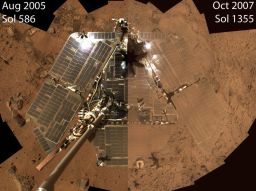 A dusty start to Spirit's winter
A dusty start to Spirit's winterThis image juxtaposes two "deck pans" captured by the Pancam instrument on Spirit at different times in the mission. On the left is the self-portrait from the top of Husband Hill, when Spirit's deck was nearly as clean as the day the rover landed. On the right is a view taken following the global dust storm last July. Dust from the sky has settled on both the rover deck and the surrounding landscape, coloring the rover the same rust color as the dirt around it. The solar cells don't generate as much power with so much dust covering them, but Spirit is still faring well as it heads into the approaching Martian winter.
Credit: NASA / JPL / Cornell
"One of the things that's interesting about the magnetic dust [the rover is seeing] is that as the layer builds up, we're seeing correlations between iron titanium and chromium and that gives [us] a suggestion that the origin of the magnetic dust is initially igneous in nature," elaborated Yen. "We have to take multiple measurements in order to get this correlation together. The thing with the magnets is that we're looking at a very thin layer of dust on a substrate that is dominated by aluminum. So the aluminum signature is enormous and the dust composition has all the elements in it that we normally see in dust. As we take multiple measurements, [we] can see various elements move in unison and that's where the iron titanium and chromium are shown to move together. That provides a little bit of information as to where that magnetic dust may be from and we're hoping that when we get this new measurement down, we'll continue to follow the trends we've been seeing. "
The time Spirit will be able to allot for science will continue to be minimal, on the average of 1 to 1.5 hours a sol on the sols it works, for several months. Nevertheless, the rover will continue its current winter science campaign with a combination of remote atmospheric observation and other IDD activities, as power levels permit. Optimism remains high that this rover, despite the odds, will make it through the winter.
Even as dusty as things are right now at Gusev Crater, Spirit -- with its odometer holding at 7,528.07 meters (about 4.68 miles), nearly 7,000 meters past its "warranty," and the magic of MER, perhaps, swirling around -- will rove into April in a state of excellent health, with all subsystems generally performing as expected. "We have more power than we thought we would have at this point," Squyres reiterated. "And we're keeping the rover very busy."
Opportunity from Meridiani Planum
Opportunity roared gently into March, huddled on the Gilbert layer near the tri-layered rock band that circles the interior of Victoria Crater. The rover spent most of the month examining specific targets within that layer, homing in on specific little features known as "fins," such as Dorsal, a protruding piece created by minerals deposited in cracks. These minerals remained in place long after the original rock eroded away because they were more resistant to weathering. Scientists have been looking for such pristine fins ever since Opportunity first noticed them back in Eagle Crater, where the rover landed more than four years ago.
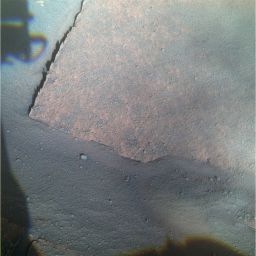 Gilbert
GilbertOpportunity took this image of bedrock within the stratigraphic layer dubbed Gilbert. This is the target the rover examined after completing its study of the three stratigtaphic layers that form a bright band around the inside of Victoria Crater. Opportunity used its Pancam to capture this image at a low-Sun angle local solar time 3:30 p.m. on Sol 1429 (Jan. 31, 2008). This image combines separate pictures taken through Pancam filters centered on wavelengths of 753 nanometers, 535 nanometers and 432 nanometers. It is presented in a false-color stretch to bring out subtle color differences in the scene.
Credit: NASA /JPL-Caltech / Cornell
Throughout March, Opportunity completed an impressive agenda of science investigations every week of the month, conducted its regular monitoring of atmospheric dust with the panoramic camera (Pancam), received instructions directly from Earth via its high-gain antenna, and continued regularly relaying data to Earth via the UHF antenna on the Odyssey orbiter.
During the early sols of the month, Opportunity acquired microscopic imager (MI) pictures of Dorsal, used the Mössbauer spectrometer to check out the iron content of a nearby fin nicknamed Dorsal Tail, and on Sol 1463 (March 5, 2008), began work on a super-resolution mosaic of images of the rim of Victoria Crater. Dubbed the Rimshot Panorama, the picture will encompass the crater rim from Cape Verde to Cabo Frio.
Opportunity also spent time during the first week of March measuring argon gas in the Martian atmosphere with the APXS, taking a Pancam survey of the horizon, full-color Pancam images of a cobble nicknamed Jin on the slope above the rover, and super-resolution images of a rock target behind it in the third layer, Lyell Oxford. The rover finished out the first week of the month taking more images for the super-resolution Rimshot Panorama and participating in a UHF relay of data with the Mars Reconnaissance Orbiter (MRO) as part of a Pancam data compression test.
The rover and its team took care of some engineering business as well that first week of March, conducting more tests on its instrument deployment device (IDD) or robotic arm, which has from time to time in recent months been suffering a stall in Joint 1. "There have been some engineering activities to try and reduce the occurrences of these Joint 1 stalls that have taken place when we've been operating the IDD," Matijevic said. "The engineers here at JPL have started to put some of those new parameters in place and there will probably be others that they will exercise in coming weeks. It will probably be a little while for us to assess how well these new parameters work."
During the second week of March at Merdiani Planum, Opportunity continued the Mössbauer investigation of Dorsal Tail's iron content on Sol 1466 (March 8, 2008) and as the week progressed it took stacks of MI pictures of Dorsal Tail and another target nearby called Dorsal New. It also took "sky flats" with the navigation camera and spot images and thumbnail images of the sky with the Pancam, as well as completed work on the super-resolution Rimshot Pan.
Throughout the mission and from time to time throughout March, Opportunity has devoted time to taking images of the sky and looking at the clouds. By studying the clouds on Mars scientists can better understand how water vapor is transported around the planet and learn about the planet's seasonal and daily weather patterns. They can also estimate wind speed and direction based on the movement of the clouds. For example, on the extremely cold Red Planet, surface ice warmed by sunlight can briefly turn to vapor that rises into the atmosphere and then quickly cools to form ice crystals again, either in clouds or back on the ground.
After Opportunity completed scientific studies of the undisturbed surface of the rock target Dorsal and the other Dorsal targets, it turned its attention and its RAT to grinding into the rock surface at Gilbert_A. Once the surface was brushed, "a 2-3 sol activity," said Matijevic, the rover placed its Mössbauer spectrometer in the RAT hole and APXS to measure the chemical composition of the rock's interior.
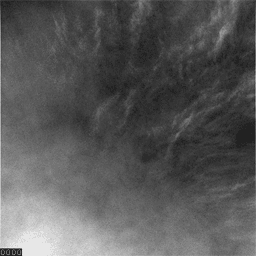 Clouds over Victoria
Clouds over VictoriaOpportunity turned its rover eyes skyward to observe clouds drifting overhead in March, much like it has throughout the mission. The clouds it capturedpassing over Victoria Crater this month look like cirrus clouds on Earth, featherlike formations composed mostly of ice crystals. Credit: NASA / JPL-Caltech / Cornell / ASU / Texas A&M / Navigation camera
Since each of the targets the rover checked out up close this month are on the same rock within a 10-centimeter by 10-centimeter area, "the rover didn't move at all," Matijevic said. Much like its twin, it's been in a solitary position, assessing the location of targeted features, putting the spectrometers down, and making measurements. The work is painstaking and can be really time consuming. "It's been a three-week activity on the part of the vehicle," Matijevic expounded. "This is understandable since the Mössbauer spectrometer now requires on the order of 40 to 50 hours of integration to get good measurements. However, this makes for a substantial investment of time on the part of the vehicle to acquire these kind of measurements at this location."
No one's complaining about the time it takes though. After all, the Mössbauer's radioactive power source has been slowly decaying since the instrument, which was designed, built, and contributed by Germany, was put into use for a guaranteed 40 sols more than four years ago. Besides that, the recent measurements were a success.
"We've got it all done now," summed up Squyres. "We've done Steno, Smith, Lyell and Gilbert. The main chemical trends that we're seeing is the sulfates dropping off, especially magnesium sulfate, and the chlorides going up as we move deeper in the crater, exactly the same thing we saw at Endurance six kilometers to the north. What that means is that the processes that resulted in that redistribution of salts were regional in scope."
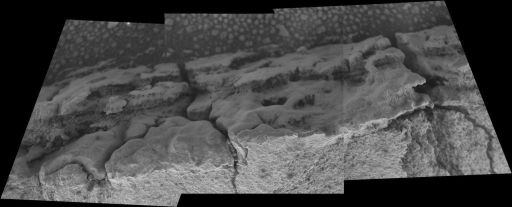 Roosevelt
RooseveltOpportunity took the images for this mosaic with its microscopic imager on Sol 727 (Feb. 8, 2006). It shows the detailed structure of a small fin-like structure the team dubbed Roosevelt, which sticks out from the outcrop pavement at the edge of Erebus Crater. The image shows fine laminations (layers about 1 millimeter or .04 inch thick) that run parallel to the axis of the fin. Some of the textures visible in the image indicate that minerals precipitated from the outcrop rocks, but sediment grains are also apparent. Credit: NASA / JPL / Cornell / USGS
The data is just down though and MER science team members have only really begun to analyze it. "This is very new," said Yen. "We just got the APXS data down last week, so we're spending some more time thinking about. We've obviously had a lot of time to think about the data from Endurance, but it wasn't until last week that we realized that there really is a consistent pattern through these two craters that are separated by a fairly large distance."
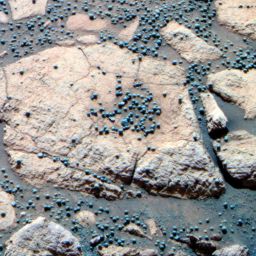 Opportunity's first "berry bowl"
Opportunity's first "berry bowl"Opportunity took this false-color composite image at the bedrock the team called Opportunity Ledge. It shows finely layered sediments that have been accentuated by erosion, sprinkled wtih the sphere-like grains or "blueberries," which are geologic features called concretions that form in preexisting wet sediments. By studying the berry bowl scientists found that much of the hematite at the Meridiani landing site is in the "blueberries."Credit: NASA / JPL / Cornell
Data collected with the Mössbauer and APXS on the fins in Gilbert, meanwhile, show that they contain large quantities of the mineral hematite, the very same iron-bearing mineral abundant in the frequently occurring, round concretions dubbed "blueberries" by the team, which are believed to have formed in water. "We're still trying to figure out what that's telling us. Our chemists and mineralogists are pondering that one," said Squyres.
"We just have to figure out what that means," confirmed Yen. "Every time we get a new measurement, we put our older measurements in perhaps a different light. For many of us, every time we see something new, we're trying to understand how that relates to past measurements. The Dorsal measurement, the fin, for example, to figure out what that means compositionally we're going back to look in the past, at the target called Arnold Stiefel within Endurance and Roosevelt, a target midway between Endurance and Victoria. No concrete answers there. But the ability to get concrete data is great, because it puts older data in a broader perspective."
The scientists, Yen said, are trying to figure out what the relationship of the fins is to the spherules. "They're obviously different in shape and so was the formation of these fins that look like they kind of oozed in cracks in the blocks of rock, how does that relate to the formation of the spherules that are embedded in the rock." Stay tuned for the fin-ish on that one.
In the last couple of weeks, the MER scientists and engineers began talking about what's next for Opportunity. "It was proposed and a decision was made," Matijevic reported. Last Thursday, MER-B roved onward. "We are now headed for Cape Verde," Squyres confirmed Friday. The base destination lies about 25 to 30 meters from the rover's position at Gilbert.
A "promontory" that juts out and serves as one of the "scallops" around the rim of Victoria Crater, Cape Verde boasts some of the best stratigraphy or layered bedrock the MER team has found on the entire mission, according to previous photographs the rover has taken. Opportunity roved the first 5.5 meters (18 feet) of the journey to Cape Verde on Sol 1484 (last Thursday, March 27, 2008) and followed that with another 5 meter (16.4-foot) drive on Sol 1486 Saturday (March 29, 2008).
 Duck Bay Panorama
Duck Bay PanoramaWhen Opportunity landed at Meridiani Planum in January 2004, Victoria Crater seemed like an unattainable goal. But after a journey spanning 21 months and almost 10 kilometers (6 miles), Opportunity finally arrived in September 2006 to spectacular views of steep cliffs cut through 15 meters of Martian bedrock, a new view into the history of a once-water-rich place on Mars. This view into Victoria Crater was taken from a point named Duck Bay on Sols 952 and 953. Cape Verde is easily visible on the left side of the image. Clicking to enlarge shows the image at half its original resolution; for the full version, visit the Pancam team website. Credit: NASA / JPL / Cornell
"For the most part, the rover drivers are guiding Opportunity across slope on the exposed "rock plates," as Matijevic describes them, the patches of bedrock that line the inner slopes of the crater's walls. "Whenever we've driven where there's a fair amount of sand or sand on these rock plates, we've experienced a good deal of slipping," he said. Although there is a sandy area the rover will have to cross to get to the desired spot at Cape Verde's base, it's a small region by comparison to the "plated" areas that serve as the main pathway. Since this drive will be conducted in the usual "careful manner," it may take until the end of the first week in April to get there, "if all goes well," Matijevic said.
"We're hoping to get close enough to reach out and touch the face of this cliff," Squyres said Friday. There are a number of things that make that "kind of scary," he said. "One is that there is a very steep and rocky slope right below the cliff and those are always difficult to maneuver on."
The MER rover drivers have had experience with steep, rocky slopes, particularly with Spirit when it was hiking up Husband Hill. "If you think back to Hilary, at the top of Husband Hill, that was an outcrop where we were on a steep rocky slope and reaching up to touch a vertical face," Squyres recalled. That vertical face, however, is not nearly as big as the one the rover will soon confront at Cape Verde. Undaunted, Squyres rationalized, cautiously: "We'll have to deal with the steep slopes and what could be some pretty loose debris, but we have thought about this."
The other "scary factor," Squyres said, is that in the position the rover will be in at the base, the cliff will effectively block out half of the sky. "Think about that -- if you're a solar-powered rover that communicates with another planet, having half the sky blocked out is a scary thing." Opportunity's Odyssey communications passes will be "truncated," he said. Moreover, in certain configurations at certain times of the day, the cliff will cast shadows on the rover. "If you're a solar-powered rover, that's not a good thing," he added.
"It's going to be interesting," Squyres offered. "But we have looked at this very hard and very carefully. We’re not going to take any undue risks. We think we can do it, but it is going to push the rover and the team right to the edge of what we feel we're capable of. It's going to be exciting."
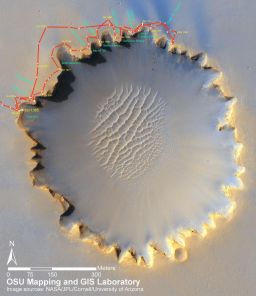 Victoria Crater
Victoria CraterVictoria Crater, which is about 800 meters (one-half mile) in diameter, has been home ground for Opportunity for 19 of the rover's 50 months on Mars. This view shows its path overlaid on a HiRISE image of the crater from the Mars Reconnaissance Orbiter (MRO). Opportunity first reached the crater's rim on Sept. 27, 2006, during the 951st Martian day, or sol, of the rover's work in the Meridian Planum region of Mars. The rover then explored clockwise about one-fourth of the way around the rim before returning to a point close to its first overlook. On Sol 1293 (Sep. 13, 2007), the rover began a sustained exploration of the interior of the crater, entering at an alcove called Duck Bay on the western side of Victoria. This map includes the rover's route though its Sol 1365 (Nov. 26, 2007). The scale bar is 300 meters (984 feet) long.
Credit: NASA / JPL-Caltech / UAz / Cornell / OSU
The plan for Opportunity now is to get over to the Cape Verde base, get some close-ups of the "spectacular stratigraphy there," as Squyres described it, and move along. "At the same time, As is typical, Squyres refused to guess-estimate on how long Opportunity would hang out at the base of Cape Verde. "Once we get there, we're going to be on a very steep slope tilted away from the Sun and we're not going to have a lot of power, so to get the science done, we'll have to stay there a while. We'll see."
Matijevic, however, cautioned that Opportunity shouldn't stay too long. "One of the constraints on the time spent for the observation [at this location] is that getting into position here will place the vehicle at a fairly significant southerly tilt," he elaborated. "Obviously, at this time of year at Meridiani the Sun is north, so you get a somewhat reduced energy profile in this location. But the reason for trying to do this investigation at this time is because there are still reasonable resources, energy resources even when the rover will be south-facing toward, in this case, toward the cliff face."
Beyond capturing some close-up pictures of the Cape's strata, the scientists will also wanting to be doing some IDD work. "There is part of the strata that is actually exposed in a position where the IDD can actually reach safely," Matijevic informed. "But after a couple of weeks, we should be moving out of that area simply because of the solar energy production."
Opportunity, which as of today, Sol 1488 (March 31, 2008), boasted an odometer reading of 11681.80 meters (7.26 miles), has been showing power levels averaging around 380 watt-hours, as it continues to put in a 5-hour workday on the sols it works. Although its energy is down from it 430 watt-hours average in February, it's "right in line with what we expected," said Matijevic, and in every other sense, this rover and all its subsystems are healthy and operating normally.
For now, all eyes at Meridiani are on the base of Cape Verde. The stereo images the rover took of this "promontory" from the rim last year show striking layers within the bedrock. "The Pancam image we're going to take once we get into position at the base is going to be just stunning, like nothing you've ever seen," Squyres promised. Opportunity is slated to make another drive tomorrow -- on Sol 1489 (April 1, 2008) -- no foolin,' which should put it more than halfway to Cape Verde's base. "Just wait," said Squyres, "until we're right on top of it."
The Time is Now.
As a Planetary Defender, you’re part of our mission to decrease the risk of Earth being hit by an asteroid or comet.
Donate Today

 Explore Worlds
Explore Worlds Find Life
Find Life Defend Earth
Defend Earth



